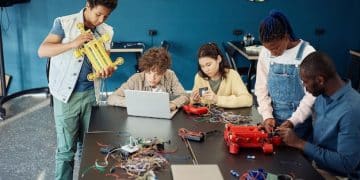Bridging the Gap: Understanding the Digital Divide in Education

Understanding the digital divide in education is crucial for ensuring equitable access to learning tools and resources for all students, particularly those from underserved communities who face significant barriers to technology and internet access.
The proliferation of technology in education has created unprecedented opportunities for learning, yet it has also exposed a stark reality: the digital divide. Understanding the digital divide in education is not merely about access to computers and the internet; it’s about ensuring that all students, regardless of their socioeconomic background, have the resources and skills needed to thrive in the digital age.
Defining the Digital Divide in Education
The digital divide in education refers to the gap between students who have access to technology and the internet and those who do not. This divide significantly impacts educational outcomes, as students without access are often at a disadvantage in completing assignments, conducting research, and developing essential digital literacy skills.
This disparity isn’t just about having a device; it encompasses a range of factors including reliable internet access, digital literacy skills, and the availability of technical support.
Access to Technology
The most obvious aspect of the digital divide is the lack of access to devices such as computers, laptops, and tablets. Many low-income families cannot afford these devices, making it difficult for their children to participate fully in digital learning activities.
Internet Connectivity
Even if a student has a device, reliable internet access is crucial. Many rural and low-income areas lack the infrastructure necessary to provide high-speed internet, leaving students unable to complete online assignments or participate in virtual classes.
- 💻 Device Accessibility: Ensuring every student has access to a working computer or tablet.
- 📶 Reliable Internet: Providing high-speed internet access to all students, regardless of their location or income.
- 👨🏫 Digital Literacy: Equipping students with the skills needed to navigate and use technology effectively.
- 🔧 Technical Support: Offering ongoing support to troubleshoot technical issues and maintain devices.
Bridging this divide requires a multifaceted approach that addresses not only the availability of technology but also the skills and support needed to use it effectively. Without such efforts, the digital divide in education will continue to exacerbate existing inequalities.

The Impact of the Digital Divide on Students
The impact of the digital divide extends far beyond just access to educational resources; it touches nearly every aspect of a student’s academic and future success. Students without adequate access to technology are often excluded from opportunities that their connected peers enjoy.
This exclusion can manifest in several ways, affecting their academic performance, skill development, and overall well-being.
Academic Performance
Students without internet access at home often struggle to complete homework assignments that require online research or submission. This can lead to lower grades and a feeling of being left behind.
Skill Development
Digital literacy is an essential skill in today’s world. Students who lack access to technology miss out on opportunities to develop these skills, which are crucial for future employment and participation in the digital economy.
Moreover, the lack of access can create a cycle of disadvantage, where students fall further behind each year.
- 📝 Homework Completion: Ensuring students can complete assignments without technology barriers.
- 📚 Access to Resources: Providing access to a wealth of online educational materials.
- 🌐 Future Opportunities: Equipping students with skills for higher education and employment.
Social and Emotional Well-being
The digital divide in education can also affect a student’s social and emotional well-being. Feeling excluded from online social activities and educational opportunities can lead to feelings of isolation and low self-esteem. By addressing the digital divide, we can create a more equitable and supportive learning environment for all students.
Strategies for Bridging the Digital Divide
Addressing the digital divide requires a comprehensive strategy that involves collaboration between schools, communities, and government organizations. Numerous initiatives can be implemented to ensure that all students have equal access to technology and digital resources.
From providing devices to offering digital literacy training, these strategies aim to level the playing field and promote academic success for all students.

Providing Affordable Internet Access
One of the most critical steps in bridging the digital divide is ensuring affordable internet access. Government programs and community organizations can work together to provide low-cost internet options for families in need.
Implementing One-to-One Device Programs
Many schools have implemented one-to-one device programs, providing each student with a laptop or tablet. This ensures that all students have access to the technology they need for learning, both in the classroom and at home.
- 💰 Subsidized Programs: Offering discounted internet and device options for low-income families.
- 🤝 Public-Private Partnerships: Collaborating with internet providers to expand access in underserved areas.
- 🏫 School-Based Initiatives: Equipping schools with the resources to provide devices to all students.
By focusing on equitable access, digital literacy, and community support, we can make significant strides in bridging the digital divide in education and ensuring that all students have the opportunity to thrive in the digital age.
The Role of Digital Literacy Training
Providing access to technology is only one part of the solution. Equally important is digital literacy training, which equips students with the skills they need to use technology effectively and safely. Digital literacy includes skills such as navigating the internet, evaluating online sources, and using digital tools for learning and collaboration.
Without these skills, students may struggle to make the most of the available technology and risk falling further behind.
Curriculum Integration
Digital literacy should be integrated into the curriculum at all grade levels. This ensures that all students receive consistent and comprehensive training in essential digital skills.
Teacher Training
Teachers also need to be trained in digital literacy so they can effectively teach these skills to their students. Professional development opportunities can help teachers stay up-to-date with the latest technologies and teaching strategies.
Investing in digital literacy training is essential for ensuring that students are not only connected but also capable of using technology to enhance their learning and achieve their full potential.
Community Partnerships and Support
Community partnerships play a crucial role in bridging the digital divide. By collaborating with local organizations, schools can provide additional resources and support to students and families in need. These partnerships can offer a range of services, including computer labs, tutoring programs, and digital literacy workshops.
Community centers and libraries can also serve as valuable resources, providing free internet access and computer training to students and adults.
Mentoring Programs
Mentoring programs can pair students with adult volunteers who provide guidance and support in developing digital skills. These programs can be especially beneficial for students who lack access to technology or digital literacy training at home.
- 🏢 Local Organizations: Partnering with community centers to offer free internet access and training.
- 🧑🏫 Volunteer Programs: Engaging community members to mentor students and provide technical support.
- 🤝 Public Libraries: Utilizing libraries as hubs for digital literacy resources and training.
By fostering strong community partnerships, we can create a supportive ecosystem that empowers students to overcome the challenges of the digital divide in education and thrive in the digital age.
Measuring the Impact of Digital Inclusion Initiatives
To ensure that digital inclusion initiatives are effective, it is essential to measure their impact. This involves tracking key indicators such as student access to technology, internet connectivity rates, and digital literacy skills. Data can be collected through surveys, assessments, and feedback from students, teachers, and parents.
By analyzing this data, schools and communities can identify areas of strength and areas where additional support is needed.
Tracking Progress
Regularly monitoring progress allows for adjustments to be made to the initiatives, ensuring that they are meeting the needs of the students and community.
Stakeholder Feedback
Gathering feedback from stakeholders ensures that the initiatives are aligned with the needs and preferences of the community.
By measuring and analyzing the impact of these initiatives, we can ensure that they are effective in bridging the digital divide in education and promoting equitable access to technology and learning opportunities for all students.
| Key Aspect | Brief Description |
|---|---|
| 💻 Device Access | Providing devices like laptops to students. |
| 📶 Internet Access | Ensuring reliable internet connectivity for all. |
| 👨🏫 Digital Literacy | Offering training in essential digital skills. |
| 🤝 Community Support | Engaging local partners for resources and aid. |
Frequently Asked Questions
▼
The digital divide in education refers to the gap between students who have access to technology and the internet and those who do not, impacting their educational opportunities.
▼
Bridging the digital divide in education is crucial for ensuring all students have equal access to resources, improving their academic performance and future prospects.
▼
Strategies include providing affordable internet access, implementing one-to-one device programs, and offering digital literacy training to students and teachers.
▼
Communities can help by partnering with schools, offering free internet access at libraries, and establishing mentoring programs to support digital literacy.
▼
The impact can be measured by tracking student access to technology, internet connectivity rates, and digital literacy skills through surveys and assessments.
Conclusion
Understanding the digital divide in education is paramount to fostering an equitable learning environment for all students. By implementing comprehensive strategies that address access, digital literacy, and community support, we can bridge this divide and empower underserved students to thrive in the digital age, ensuring they have the tools and skills necessary for future success.





